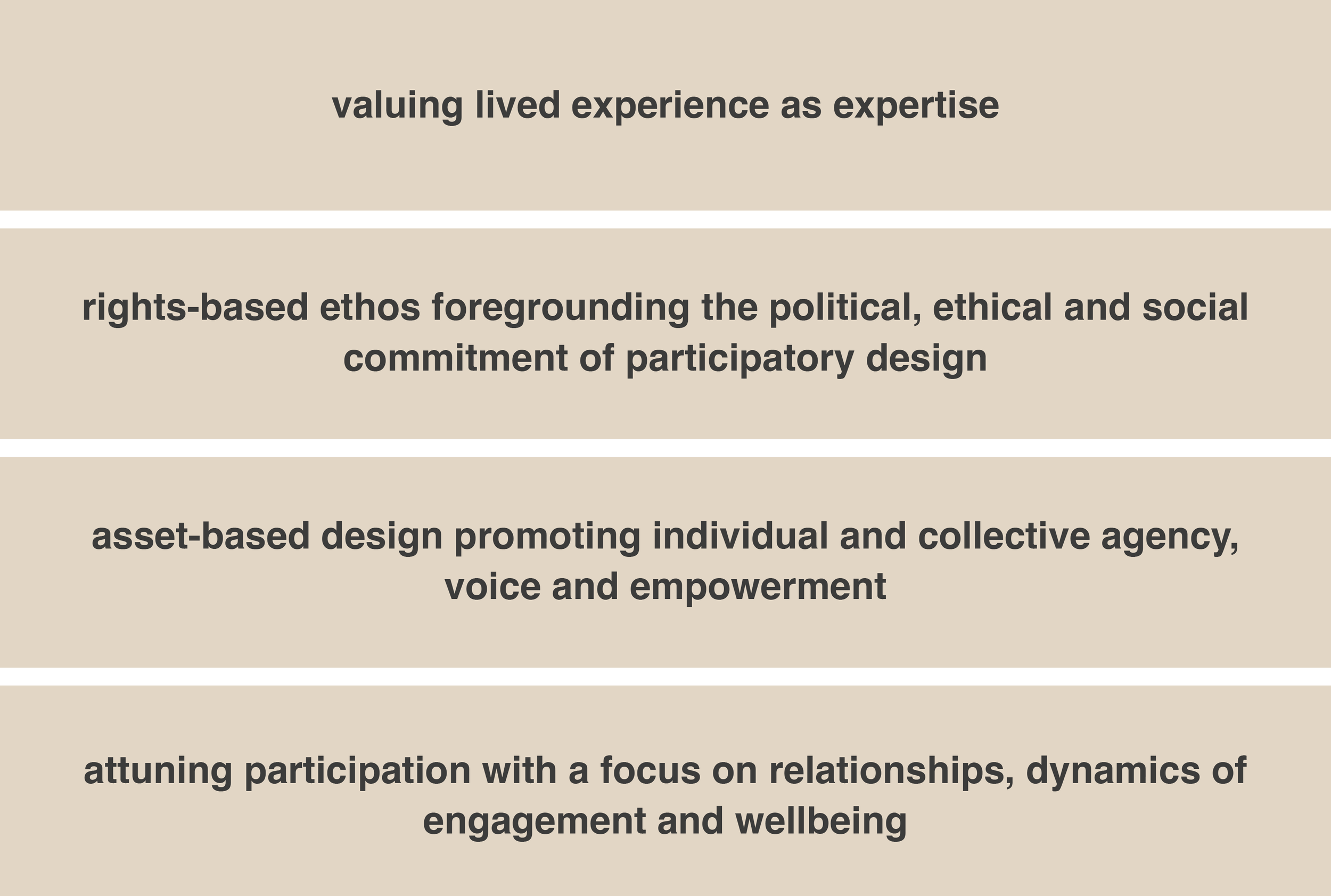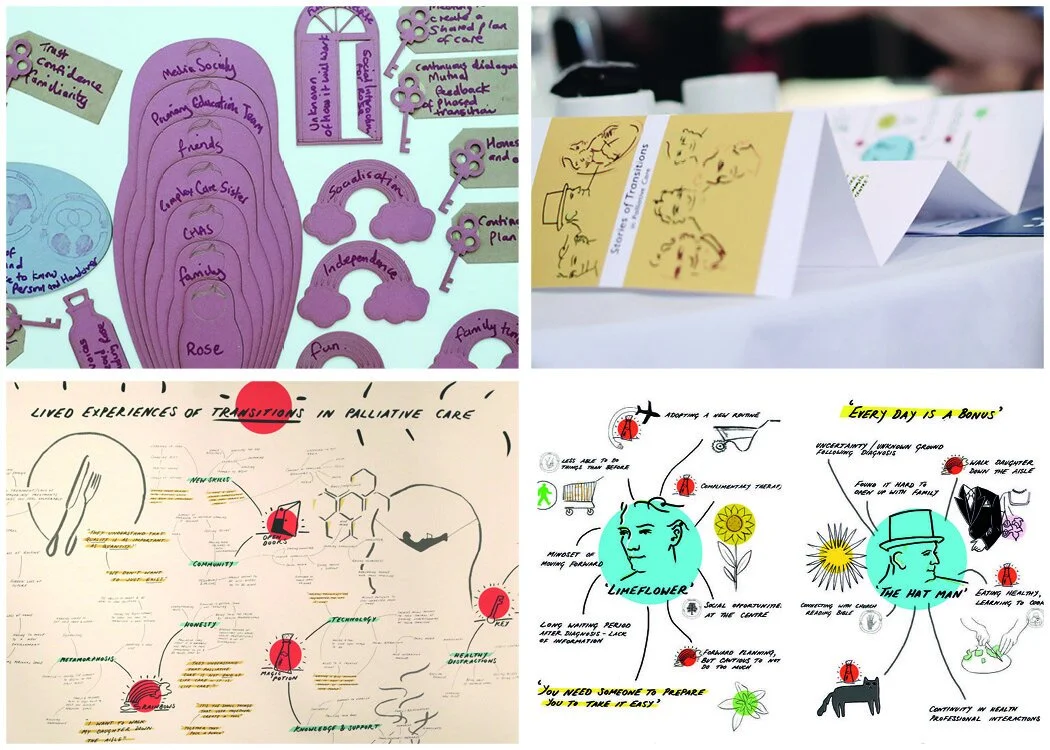Genuine Co-design with People with Lived Experience
Introduction
Co-design is becoming a well-known term outside of the design domain – a promising shift showing a growing awareness of the potential and value of design beyond its perceived traditional role in creating products and artefacts, to synthesising complexity and driving transformation in complex areas such as health and care. However, with an increase in the adoption of ‘co design’ methods as a preferred (sometimes, prescribed) way of doing things, we see an emerging trend of multiple and sometimes conflicting understanding of what it means and how it is enacted in practice. Most notably, the core ethos of co design – designing ‘ with’ people not ‘ for’ – is misunderstood or misrepresented when participation takes tokenistic forms.
We have been exploring these questions through our participatory design practice and research.
Many of our publications in recent years have sought to address this, building on reflections and learnings from a number of projects from our research portfolio, including: Future Transitions in Palliative Care, Game Jam, Ritual Respect and Bringing Communities and Care Together.
Below is a summary of our publications around the theme of genuine co-design, and overview of what it means for evolving research and practice in this area.
Significance to research and practice of co-design
Understanding what is genuine co-design
Our book chapter titled Towards a Shared Understanding of Genuine Co-design with People with Lived Experience, shares our learnings and reflections on genuine co-design, using examples to articulate characteristics of co-design and conditions for enabling genuine participation in the co-design process.
Existing literature acknowledges the breadth of understanding and application of co-design in relation to recognition of people’s expertise, their contribution in decision-making, engaging different people early and creatively in a design-led process, and the approaches required to enable participation tailored to different expertise. Whilst we acknowledge that co-design may be applied in different ways depending on context, we propose the need for awareness of the distinction across practices, leading us to consider how we understand ‘genuine’ co-design in our practice.
Our learnings and refections have contributed to a nuanced understanding of genuine co-design as:
“Genuine participation of people with lived experience as partners throughout all stages of a design-led process, enabled by: valuing lived experience as expertise and framing participation to meaningfully embody people’s everyday lives and experiences; reflecting on lived experience and empowering people to engage in creative exploration and conceptual decision-making; and attuning participation to nurture relational and transformational experiences and outcomes during and beyond engagement in co-design.”
By genuine we don’t mean a single, standardised or “better” way of practicing co-design, but understanding how different forms of co-design build on the key principles and ethos of genuine participation that are attuned to the people, context, and outcomes that they seek to engage with. The aim is to invite further dialogue with the wider practice and research communities to develop a shared understanding of what is (and what is not) genuine co-design.
Developing a Conceptual framework FOR ENABLING GENUINE PARTICIPATION
The article Participatory Design in Sensitive Contexts: A Proposal for a Conceptual Framework discusses our work specifically focused on enabling genuine participation from people perceived as vulnerable to engage on sensitive topics during co-design. The work addresses a key gap in theory related to shared learnings and key principles across different sensitive contexts, and examples of how these are enacted in practice.
Enabling genuine participation and outcomes towards personal, collective and social transformations are central to the framework, and the framework emphasises:
Credit: Raman and French (2022) (For the detailed framework, see Table 2 here.)
We invite further dialogue with other design researchers and practitioners on what genuine participation and transformative outcomes mean in the practice of participatory design across diverse sensitive contexts.
While the examples and framework in the paper focus specifically on projects with people who may be perceived as vulnerable, it can be more broadly applied to focus on inclusivity and diversity of perspectives in any co-design process.
ENACTING A Situated and tailored APPROACH FOR CREATING CONDITIONS FOR GENUINE PARTICIPATION
Our papers on Enabling Genuine Participation in Co-design with Young People with Learning Disabilities and Engaging People with Lived Experience in Co-design of Future Palliative Care Services delve deeper into our participatory approach and ways of enabling genuine participation using bespoke methods and tools, through critical reflection on two projects. They provide insight into our situated and tailored practice of co-design – attuning to the people, context, and outcomes, to create appropriate conditions for genuine participation from people with lived experience.
The first project aimed to co-design a game-based learning tool about online safety with young people with learning disabilities. Findings highlight the importance of contextual preparation by embedding in situ to support multi-vocal, multi-method engagement; and asset-based narratives to empower young people and support expression of voice, enabling creativity and conceptual decision-making.
Image credit: Louise Mather
The second project focused on engaging with people with lived experience of palliative care to explore future transitions in palliative care. Findings and critical reflections highlight the value of an asset-based approach for reframing vulnerability, and visual and narrative tools for sensitively engaging people with lived experience of palliative care transitions, and making their lived experiences visible and intrinsic to the co-design process.
Image credit: Louise Mather, Illustration credit: Tessa Mackenzie
WHAT’S NEXT?
We would like to hear from other practitioners and researchers on their experiences of enabling genuine participation from people with lived experience in co-design across a range of contexts, and continue to:
develop a shared understanding and vocabulary for genuine co-design
evolve the conceptual framework for participatory design in sensitive contexts, and foreground inclusivity and diversity of perspectives in co-design more broadly
share examples from practice of how genuine co-design is enacted in situ, and build on methods and tools that enable this
If you would like to know more, or would like to collaborate with us on this, please contact: s.raman@gsa.ac.uk
Authors
Sneha Raman and Tara French
Further information
Sneha Raman, s.raman@gsa.ac.uk
Tara French, t.french@gsa.ac.uk
Related publications
French, Tara and Raman, Sneha (2021) Engaging People with Lived Experience in Co-design of Future Palliative Care Services. International Journal of Public Administration, 44 (9). pp. 778-789.
Raman, Sneha and French, Tara (2022) Towards a shared understanding of genuine co-design with people with lived experience: reflections from co-designing for relational and transformational experiences in health and social care in the UK. In: Morton, S (ed.), Designing Interventions to Address Complex Societal Issues. Design Research for Change . Routledge.
Raman, Sneha and French, Tara (2022) Participatory Design in Sensitive Contexts: A Proposal for a Conceptual Framework. The Design Journal: An International Journal for All Aspects of Design, 25 (5). pp. 752-767.
Raman, Sneha and French, Tara (2021) Enabling Genuine Participation in Co-design with Young People with Learning Disabilities. CoDesign.




